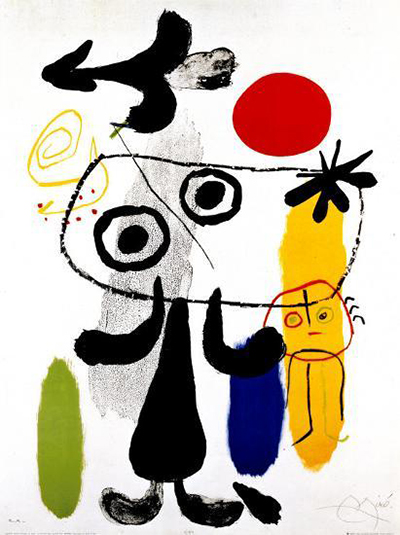In Figur Gegen Rote Sonne II, painted around 1950 when Miro was living in Barcelona, we see many of the elements of the mature artist that most people would recognise.
At the centre of the painting we can see the eponymous figure, childlike in its simplicity with the abstract painter's confident disregard for anatomical veracity. To the central figure's left we can make out a second presence, this time painted with a more overtly sombre expression. In Figur Gegen Rote Sonne II Miro includes many of the tropes for which he is famous, the large red sun high in the sky sharing the space of the upper portion of the canvas with the ever present image of a bird. For Miro the bird symbolised freedom of course but also innocence and a desire for the simple and honest.
The bold blocks of primary colours create a sense of energy and joy, but on closer inspection, along with the slightly unsettling features of the second figure we begin to notice the heavy use of black and the long grey shadow that dominates the background of the piece. Miro's work often attempted to depict the mysterious life of the subconscious and the unfathomable world of dreams. In Figur Gegen Rote Sonne II we see an artist displaying an incredible mastery of light and shade, not merely in his use of paint but in the manner in which he creates both a sense of joy and wonder tinged with a hint of the darkness that lives within us all.
Born in Catalonia in Spain at the tail end of the nineteenth century, Joan Miro was one of the leading figures in the nascent European modern art movement. His paintings and sculptures, instantly recognisable, display a daring and innovative use of colour and form and the language that he pioneered in his work has become an integral and highly influential part of our understanding of contemporary art. Although Miro began by painting relatively conventional landscapes of his native Spain, by the time he was in his early twenties he had begun to experiment with expressionist and abstract ideas. We see the progression of his work moving him away from literal representations of the world around him to the use of a far more minimal set of signs and symbols and a growing desire to describe internal rather than external experiences.




